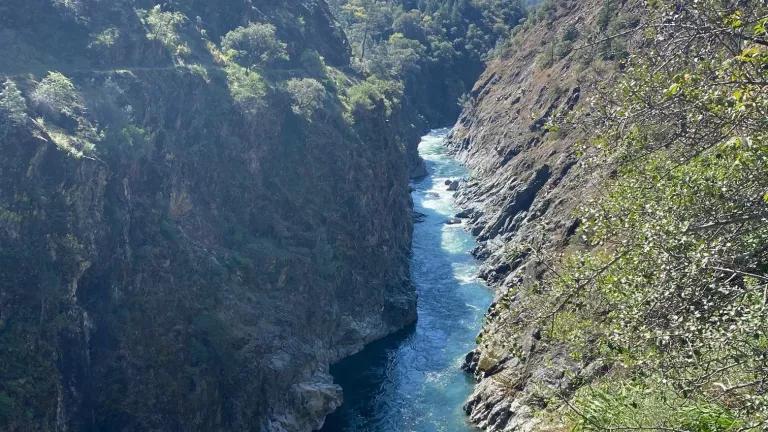The Bay-Delta Salmon Crisis That Didn’t Have to Be
Enough with playing politics with the heart of California’s freshwater system. It is well past time for both the state and federal governments to update standards for salmon management in the Bay-Delta.

The state and federal agencies tasked with protecting our fish, wildlife, and natural resources are once again scrambling to avoid wiping out this year’s cohort of chinook salmon that spawn below Shasta Dam. If this sounds familiar, it is because this scenario is a repeat of attempts to “manage” Shasta operations in 2014 and 2015, which resulted in over 75% of the eggs and fry of endangered winter run chinook salmon being destroyed in both of those years, solely from the lack of sufficient cold water being released from Shasta Dam (overall in-river mortality rates for winter run born in 2014 and 2015 exceeded 95%). Fall run chinook salmon, that form the backbone of the west coast salmon fishery, fared even worse in their Sacramento River habitat in 2014. We’ve heard lots of proclamations this year about how California learned its lessons from the severe drought of 2012-2016 and won’t repeat the mistakes of that era, which were horrific for fish and wildlife. But here we are again, with some of California’s last struggling salmon runs still not fully recovered from the last drought and once again facing extinction-level mortality events in the wild.
The question is: why are we here again? The answer is not complicated:
- The State Water Resources Control Board, appointed by Governor Newsom, has not updated woefully out-of-date water quality standards on the Sacramento River and in the Delta, standards which would include measures to avoid the wholesale slaughter of chinook salmon that periodically occurs below Shasta Dam; and
- The federal Interior Department and National Marine Fisheries Service have not yet withdrawn the Trump-era biological opinions in the Bay-Delta, that are so bereft of any scientific justification that they actually permit 100% of the endangered winter run salmon that spawn below Shasta Dam to be killed by overly warm water temperatures in a year like this one.
California’s State Water Resources Control Board has been working to update the 1995 water quality standards that currently regulate San Francisco Bay-Delta operations since 2009. This “triennial review” is now decades overdue, meaning that the water quality standards that we rely on to protect the state’s most important estuary, source of drinking water, and irrigation water supply fail to reflect the most basic conditions on the ground or current scientific information. Since the 1995 plan went into effect, the Bay-Delta has experienced ecosystem collapse on a scale that has shocked scientists, with several of its native fish—the canaries in the coal mine for ecosystem health—experiencing population declines in excess of 95%. We know how to address these declines. With regard to maintaining cold water habitat for salmon below Shasta, a scientific basis report prepared by a group of eminent scientists for the State Water Board in 2017 recommended the following:
Maintain stream flows and reservoir storage conditions on the Sacramento River and its tributaries and Delta eastside tributaries to protect cold water habitat for sensitive native fish species, including Chinook salmon, steelhead, and sturgeon. Cold water habitat conditions to be protected include maintaining sufficient quantities of habitat with suitable temperatures on streams to support passage, holding, spawning, incubation, and rearing while preventing stranding and dewatering due to flow fluctuations.
If standards had been updated as recommended by the scientists, we wouldn’t be scrambling to avoid killing most of the salmon below Shasta this year due to lack of cold water reserves.
The only reason that the State Water Board hasn’t acted on this information and updated water quality standards is because Governor Newsom insists that “voluntary agreements” for managing the Bay-Delta watershed would be preferable to updating standards in accordance with the law and science. But attempts to reach “voluntary agreements” have been underway since Governor Brown’s administration in 2016, with nothing to show for the effort other than unacceptable delays in updating critical water quality standards and unnecessary crisis management of Shasta Dam operations and other key infrastructure, with fish and wildlife declining ever more rapidly.
The Trump Administration's biological opinions for the Bay-Delta must also be immediately withdrawn and updated. On day one of the Biden Administration, President Biden issued an executive order calling for immediate review of some of the most egregious anti-environmental decisions made by the Trump Administration, and these two biological opinions are on that list. Immediate review was critical in this case because these biological opinions are a recipe for extinction of the Bay-Delta’s native species, including allowing for killing 100% of this year’s progeny of one of the most critically endangered species in the country. It is clear that these biological opinions were written without adherence to science and the law, and, every day they remain in place, they do more damage to the largest estuary on the west coast of the Americas. Yet, here we are, 90 days later, and the relevant federal agencies have not yet withdrawn these destructive opinions or indicated any findings of its “immediate” review.
Enough with playing politics with the heart of California’s freshwater system. It is well past time for both the state and federal governments to update standards for salmon management in the Bay-Delta. The continued survival of California’s iconic king salmon runs hangs in the balance.


